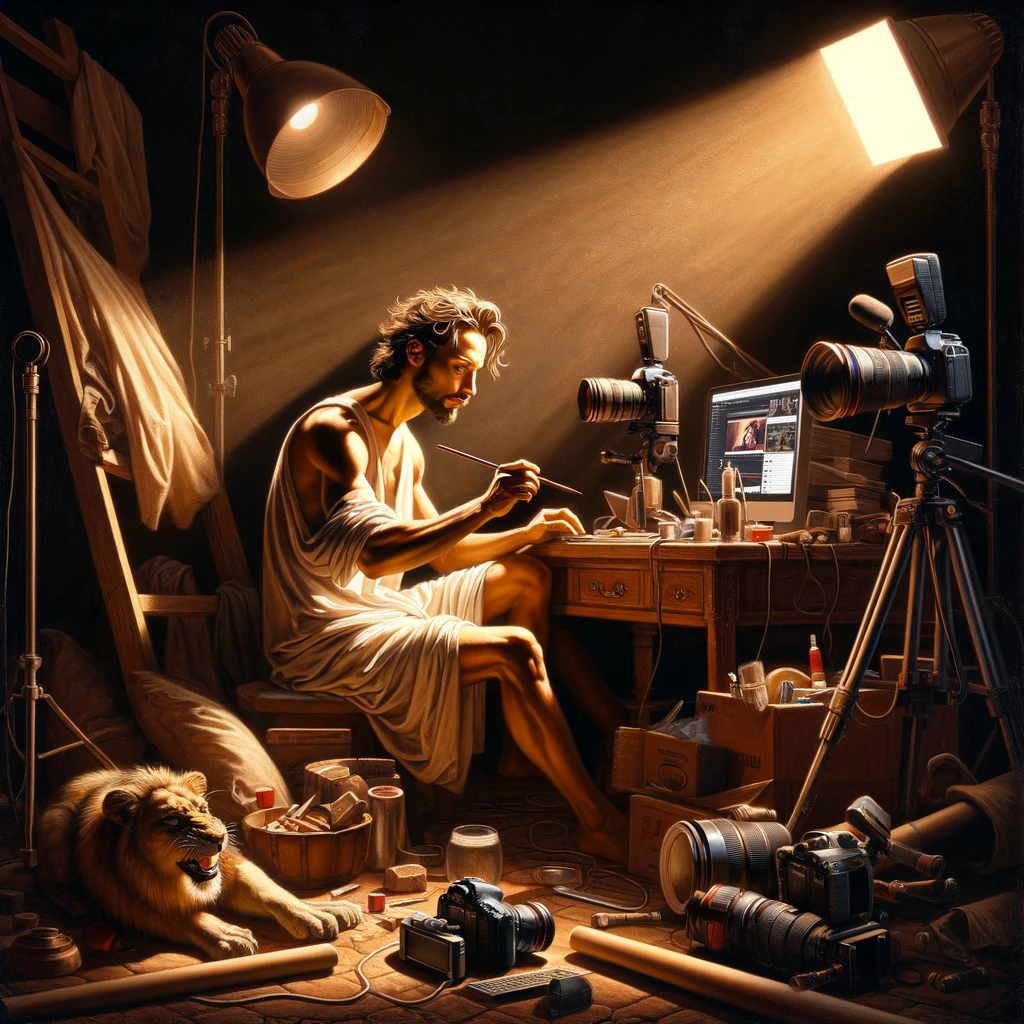
Motivi
 1: Money
1: Money
Let’s be honest money is a fairly important driver for many things we do. I’ve been pretty transparent about my earnings so I might as well use them to make this point. Just through YouTube and the audience I’ve built with it, I’ve now turned this hobby into a business which generated $4.7 million last year which is absolutely mindblowingly insane.
Back in 2019 I was working around 10 hours on the channel most weeks (on evenings and weekends) and still making more money than I was earning in my full-time job as a doctor.
Now I’ve got complete financial freedom, plus a team of 20 people, and it’s all down to starting this whole YouTube thing 
 2: Work Anywhere in the World
2: Work Anywhere in the World
When the world isn’t ending, you might be someone who dreams of/enjoys travelling, or you might just prefer staying home instead of braving the daily commute. Either way, all you need is a laptop and camera and you can work from anywhere at any time. It’s pretty cool.
 3: Freedom
3: Freedom
Morgan Housel, author of The Psychology of Money, says the value of money is that it gives you “the ability to do what you want, when you want, with who you want, for as long as you want to.”
And that’s what YouTube can give you 
My team and I have all our meetings on a Monday, so then I have the rest of the week free to film videos, write my book, go to the gym and hang out with my friends pretty much as I please. You don’t have to quit your day job, but you might get to a place where you don’t have to be there either. Work becomes a choice.
 4: Heroes and Friendships
4: Heroes and Friendships
It’s a lot easier to get a reply from your personal heroes when you can give them something back (exposure in a video for example). YouTube’s allowed me to connect with people I could only dream of, and at the same time it’s led to some amazing people getting in touch with me. Without YouTube, I doubt our paths would’ve ever crossed 
Life is really about connections and interactions, and YouTube is genuinely a brilliant way to supercharge both.
 5: Changing Lives
5: Changing Lives
One thing that never gets old is people writing in to say you’ve changed their lives. Although I do get a bit of imposter syndrome every time, there’s nothing more heartwarming than someone actually saying you’ve changed their life.
Bringing these little bits of happiness, positive change (or even humour with others making fun of you lol) is such a big plus.
 6: Impact
6: Impact
The most insane thing that’s come from this journey has been the level of impact me and my community of subscribers have had on other people’s lives.
One video I made on the Giving What You Can Pledge made 2500 to save a human life through donations to the Against Malaria Foundation). This is way more than I ever saved when I was a doctor. (For context, the average doctor saves around 20 lives in their entire career (source)).
Puts things into perspective and makes you realise the crazy potential that can come from making silly videos on the internet 
 7: It’s Really Fun
7: It’s Really Fun
Honestly, making YouTube videos is a blast 
It’s scary initially, but you learn so much with each video, and when you hit publish it’s like your little creation is going out into the world. Then you get the views, the likes and the comments, which are wholesome and supportive 99.9% of the time.
You find yourself improving over time, you start getting messages from friends saying they saw your video and they thought it was cool. It’s all pretty fun.
Miti
 Myth 1: It’s Too Late To Get Started
Myth 1: It’s Too Late To Get Started
For a fairly new platform, it feels like YouTube’s been around for a while. We’ve already seen the rise and fall of a bunch of YouTubers. Half of your favourites might be people with millions of subscribers. It’s easy to see all that, not know where the ‘upload video’ button is and think ‘this ship’s sailed’, ‘why would someone watch me’, ‘I can’t compete’.
The feeling is valid  The reasoning is not
The reasoning is not 
Most of the audience are just looking for good videos regardless of who’s made it. There’s YouTubers still going from 0 to hundreds of thousands of subscribers in months (not to rely on this, but as an example that growing from zero is still a thing - just check out one of the students from my course John Coogan) 
Loads of people tell me what they want to make videos about has already been done.
Well, yes of course. Nothing is original, and that’s to be expected.
But there’s an audience for everything and everyone, seriously. And there’s always a bigger audience on YouTube, the platform just seems to be getting larger - it’s not too late to jump in the game now.
There are no unique messages. Only unique messengers.
 Myth 2: You Need Good Gear
Myth 2: You Need Good Gear
Ah the gear. I like to think I pay a good amount of attention to visuals and detail on my channel. If you’ve seen my gear page, it looks pretty expensive. It’s not a beginners setup. It grew as my channel did.
All you need to get started is your smartphone (not even a stand, use a box or some books to prop it up  ) and a mic off Amazon. You’ll be fine. My friend Elizabeth got to 1k subscribers in two months using just an iPhone camera, and she’s gradually upgraded her gear as she’s grown, just like I did.
) and a mic off Amazon. You’ll be fine. My friend Elizabeth got to 1k subscribers in two months using just an iPhone camera, and she’s gradually upgraded her gear as she’s grown, just like I did.
In fact, if you want to get started with filming videos using just your phone, I’ve made a video explaining exactly how to do that 
If you can and want to invest in gear - absolutely do it. It’s definitely a plus (more on gear later), but it’s nowhere near enough reason not to get started. Get some natural lighting, prop up your phone and press record. It’s definitely good enough.
 Myth 3: You Need To Know What Your Niche Is
Myth 3: You Need To Know What Your Niche Is
‘But I’m interested in so many things.’ ‘I don’t know what to talk about.’ ‘Who would I make videos for?’
Honestly, you never really have your niche truly defined.
You change, they change, times change, it’s all super-fluid. And literally everyone feels the same way when they start.
We all sometimes think there’s nothing interesting about us and equally that we can’t find ‘just one thing’ to make videos about.
It’s normal.
Just pick one. The smaller your niche at the start, the better.
And then make one video. It’ll give you ideas for a second. Maybe if you’re lucky to get a question in the comments, there’s a third.
If you’re in it for the long haul, know your niche will change anyways - my channel’s certainly changed over the years. Just find something you can talk about for 3 minutes and film it.
Figure out the rest as you go 
 Myth 4: You Need To Be a Good Public Speaker
Myth 4: You Need To Be a Good Public Speaker
Not going to lie, this one kind of makes me smile. Do you need to be a good public speaker? Absolutely not. If you haven’t spoken on camera before, chances are, you’ll find your on-screen self to be an awkward mess for the first few videos 
That’s not to put you off. That’s to say it takes at least 10 videos to get used to it. And that everyone will - it’s a practised skill. When someone comes to me asking how to improve their speech on camera, I won’t really say anything until they’ve got at least 10 videos out.
Go to your favourite YouTuber’s first videos (you can filter by date) and enjoy the awkward mess that is everyone’s first few attempts at filming  The sooner you start, the sooner you get past this mandatory learning curve.
The sooner you start, the sooner you get past this mandatory learning curve.
 Myth 5: I’m Too Scared To Start, YouTubers Are Confident
Myth 5: I’m Too Scared To Start, YouTubers Are Confident
I used to be terrified of putting myself out there. But then, 5 years ago, I read a book called Show Your Work by Austin Kleon that changed my life.
It’s a book about self-promotion for people who hate the idea of self-promotion 
It helped me start my blog, and the first post I made in January 2016 was called How to get over the fear of starting a blog. In the post, I explained my thought-processes about how scared I was to start putting myself out there, and broke down the ways I got over it.
“I have to be confident to start YouTube” is a myth because almost no one’s confident when they start. Competence breeds confidence 
The more you practise, the better you’ll get. It just takes that first step to get started, and the first step is always the hardest.
If you’re terrified, you’re in good company. Just know that everyone else who’s starting, is just as scared and doing it anyway.
Being all-in doesn’t mean you do YouTube and only YouTube. I was making 2-3 videos a week for 3 years before I finally decided to leave my day job as a doctor.
I’m a huge fan of side hustles, so naturally I’m a huge fan YouTube being a Part-Time thing.
Finding content ideas, planning out videos, filming and editing - these can seem like an endless amount of work. But it really doesn’t need to take over your life, and you can very well manage it alongside everything else. Here are 5 techniques for doing just that:
Tecniche
 1: Batching
1: Batching
If you’re anything like me, your room probably isn’t always camera-ready. If you’re someone who tries to look presentable, you might not always be ready either. Whether it’s getting into the headspace to film a video, making sure the background looks ok or making sure your camera settings are ok, there’s always just so much friction to getting started. And when you’re filming multiple videos in a week you can waste just so much time ‘getting ready’ to film.
 The way forward is batching
The way forward is batching 
Pick a day. Maybe once a week or fortnight. Maybe if you’re super pro, once a month. Sit down, and film yourself doing 2, 3, maybe 5 videos at a time. It’s honestly game-changing. This way you don’t need to keep setting things up again and again every time you want to get 30 minutes of filming done. Trust me, it’s so simple but saves tonnes of time.
 2: Stealing Ideas Like An Artist
2: Stealing Ideas Like An Artist
One of the biggest things I’ve heard from people just starting out is a concern around coming up with enough ideas. A huge part of this comes from wanting to create ‘original’ content.
It’s a total myth that ideas are original. They really aren’t.
Some of the biggest artists themselves refer to their work as ‘stealing’. Of course, there are lines one can cross, but if you’re a beginner, you’re really very safe. Chances are, you won’t have the equipment, time or resources to create videos exactly like the ones you see. So you’re fine. Honestly, go for anything 
Once you let go of this idea of wanting to create something original every time (btw, if you can, go for it), you’ll find so many ideas already out there.
Create what you like to see. Make it authentic to you and you’re golden 
‘Creativity’ really doesn’t have to be that difficult.
 3: Parallel Processing
3: Parallel Processing
There are 2 types of task - heavy lifts  and slow burns
and slow burns 
A heavy lift is sitting down with a blank screen (or paper) and trying to plan out a video from nothing: no title, no topic, no ideas. Unless you have endless time, this process in unlikely to be enjoyable or sustainable.
In contrast, a slow burn is much more juicy. This is where you’re able to chip away at multiple projects at the same time.
Let’s say you see a video that resonates with you - write this title and idea somewhere. Seen a thumbnail you can recreate? Screenshot it. You read a sentence in a book making a good argument on a subject you’re interested in - add it to your resources.
Just being proactive like this means you’ll never need to start from a blank page. You’ll always have multiple little half-formed or almost-fully-scripted videos waiting for you at all times. If you block some time to add finishing touches - your content will seriously never stop flowing.
Since I’ve expanded my team our workflow system has undergone a bunch of changes, so I’m sure you’ll see a video about that sometime soon. Safe to say we arrive on a Monday with no more than a couple of one-sentence video ideas, which get fleshed out throughout the week 
 4: Systematic Structuring
4: Systematic Structuring
So you have your idea, you have some bullet-points on what you want to say - how do you turn that into a video? This is a huge topic, but here are some structuring guides that will help:
Listicles 
This is where you just go through the points you want to make one by one (like this email). It requires minimal effort and can be super successful. I’ve used this method in a few of my videos.
Essay Structure 
This is what we used to do in English Literature. And there’s a reason we used it - it makes sense and sounds good. You take an intro that explains the issue. You have a body divided into sections that ideally each make a single point. You weigh options. You compare pros and cons. You summarise in the end. It’s essentially an oral essay. Here’s a pretty personal recent example.
Story Structures 
This is the Gold Standard. This is what I wish I could be doing with every video and what I’m aiming for. Humans have evolved around stories, we love them. So if you can turn what you say into a story that follows a hero’s journey, everything will become endlessly more attractive to the viewer. Make what you say personal and show how it has transformed you, and more people will be compelled to listen. A better example of what the hero’s journey actually means is this video. And if you want to get better at storytelling, get Storyworthy by Matthew Dicks, it’ll change how you think about stories and the world in general.
 5: Efficient Editing
5: Efficient Editing
Editing takes possibly the largest chunk of time. You’ll quickly realise how many ‘umms’ and ‘ahhhs’ you’re injecting after everything. Every. Other. Word.
In my book, there’s really no excuse for having poorly-edited videos. I use Final Cut Pro X, if you search you can find endless free resources to learn it online. If you want to jump straight into the YouTube editing game, I have a Skillshare Class on Video Editing with Final Cut Pro that has 39,000 students and pretty sick reviews (you can access it for free here) - it’ll take you from beginner to pro in under 4 hours 
If you’ve entertained the idea of starting a YouTube channel, you’ve probably come across the beast of Imposter Syndrome. The feeling of ‘why on earth would anyone listen to me?’ 
This is a feeling that every YouTuber and content creator suffers from.
I’ve been battling it since day 1, and I continue to fight it everyday.
Why would I be qualified to make videos about study methods? I’m not the best student in the world 
Why would I be qualified to make videos about tech or productivity? I’m not an expert.
Why would I even make this email Crash Course about being a YouTuber? I’m still under 3m subscribers - there are people out there who are infinitely more successful on YouTube than I am. Why would anyone read what I’ve got to say?
If this is a feeling you’ve ever suffered from, hopefully you’ll find this email useful.
It’s some of the stuff I remind myself of when the Imposter Syndrome beast rears its ugly head 
Note
 1: The Curse of Knowledge
1: The Curse of Knowledge
If you’re waiting to become an ‘expert’ (whatever that means) before you get started on YouTube, you’re approaching it all wrong.
Something which isn’t said enough is that 90% of your audience will be complete beginners.
Even when you’re targeting professionals (trust me, I’ve tried).
And the issue with an expert teaching a beginner, is that they’re so out-of-touch and on a different level that they struggle to remember what the experience of the beginner is like. They just can’t connect well. CS Lewis called this the ‘Curse of Knowledge’.
 2: You Don’t Need to Know a Thing to Get Started on YouTube
2: You Don’t Need to Know a Thing to Get Started on YouTube
By still figuring things out, by being open and on a journey, even by being a bit of a mess, you’re likely to be relatable and likeable. A good mix.
You can give tips and advice the audience can immediately take away, and you can bring them along as you improve.
Just like it’s never too late to start, when we’re talking about what we know about a subject, it’s never too early to start 
You can make a video on how you’re starting something tomorrow; on why you’re thinking of starting to learn something; on figuring out how to find something to start to learn. Literally anything goes.
 3: Guide Not Guru
3: Guide Not Guru
Another thing I keep in mind is that no matter what I ‘teach’ or explain - I put myself in the position of a Guide rather than that of a Guru 
I never paint myself as someone who’s figured it all out and is spreading his wisdom (the Guru). I’m just some guy with a camera who’s trying something out to see if it works and sharing his journey with others (Guide). If you’re the latter, it’s hard to go wrong.
And as a last point, Guru credentials really don’t matter. No one cares how many diplomas you have, they just want useful content.
I know I’ve played the Cambridge card to death but I’m still no expert - I wasn’t the best candidate who ever interviewed there, even though I was making videos about it. I certainly wasn’t anywhere near the best student there, even though I was making videos about how to study.
But people still enjoyed learning from me, as I was figuring stuff out.
Talk about what you’re figuring out, and you’ll be fine.
 4: You’re Supposed to Feel Uncomfortable
4: You’re Supposed to Feel Uncomfortable
So when it comes to imposter syndrome, it may feel as though you don’t yet have the credentials to talk about what you wanna talk about.
You think that maybe in a few months, if you just read a few more books or spent a few more weeks thinking about your video ideas, you’d feel like less of an imposter in front of that camera.
But I’ve got some bad news 
That feeling will always be lurking, and our only option is to push through it 
I spoke with Steven Bartlett on his no.1 podcast The Diary of a CEO last year, and after the interview, he gave me an absolutely life changing piece of advice about imposter syndrome.
We’ll probably spend most of our lives feeling like we’re ‘not supposed to be’ in a certain place, or that we don’t deserve it, and yet we achieve everything we ever have despite those feelings.
What it boils down to is that we grow exponentially when we’re uncomfortable.
Check out the video here to hear it straight from Steven.
If you read the email I sent on day 2, you might remember me suggesting that you could literally get your phone out right now, find some natural lighting, and hit record on your first video. Because that really is all there is to it, as far as getting started goes 
But this might seem a bit too easy. Just talk to your phone and upload onto YouTube? Surely it’s not that simple. Not everyone ends up with a massive channel. There must be some secret sauce to becoming a successful YouTuber 
And you’re absolutely right.
Getting your phone out and hitting record is great for getting started but there’s definitely more to ‘making it on YouTube’.
Today I want to take you through the Top 5 things I think it takes to succeed.
Mindset
 1: Consistency
1: Consistency
This is perhaps the single, most non-negotiable, biggest determinant of your success on YouTube. And it’s not glamorous.
Pick a schedule and stick to it. Religiously. There’s so many reasons to do this.
Firstly, the YouTube algorithm favours consistent, regular creators. And you always want the algorithm on your side.
Secondly, you want someone to come to your channel and see a consistent backlog of content - if your last video is from 3 months ago and the one before that from 2018, it’s very very unlikely they’ll subscribe. I certainly wouldn’t, would you?!?
And thirdly, you want to establish an expectation, especially as you’re trying to grow. Commit to uploading on a set day each week and stick to it. People will start to get hyped for your weekly video.
If you post once on Wednesday and the next week on Friday and then on Sunday, people won’t know what to expect and will quickly switch off.
Before I hit 2 million subscribers, I was uploading 2-3 videos every week without fail. Things have changed a little now I’ve got an established audience and have started to expand the business, but I attribute a huge amount of my early growth to my consistency.
 2: Faith and Patience
2: Faith and Patience
Let me break something to you (if you hadn’t worked it out already) - YouTube is not easy 
This isn’t a get-rich-quick-scheme. For the huge majority of us, it’s a lot of work, for a long time, with absolutely no reward.
It took me 6 months and posting 53 videos to hit 1,000 subscribers. That is months of idea generating, editing, and churning out videos with little to no audience.
And the difference between those who make it and those who don’t is giving up in that painful period.
Be ready for zero views, zero engagement, zero subscribers. Expect the sound of crickets for months and months.
Set your expectations and be patient. It’s the only way to succeed 
 3: Hard Work
3: Hard Work
Yep, it’s really no different to anything else. You have to put in the time, even when you don’t feel like it.
You’re guaranteed to find some parts harder than others: maybe you particularly dislike being on camera, or editing will take a while to learn, or you hate filming in public. But what’s absolutely certain is that you’ll improve in all these areas over time. And the skills and discipline they give you are amazing and transferrable.
 4: Unfair Advantages
4: Unfair Advantages
These are really worth spending a bit of time thinking about.
What will make you stand out? 
What things are you fortunate (or unfortunate) enough to have that you can focus on?
I was a medical student (‘hard’ to achieve), at Cambridge University (mysterious, prestigious). I had good camera gear and knew a thing or two about making things look pretty so my videos seemed well designed and stood out from other medics.
How can you stack the deck in your favour? 
It might be having the money to buy the best gear out there and have sick production value from day one, or it might be your poor gut health prompting you to try different diets you can talk about.
We all have unfair advantages, it’s just a matter of realising what they are. (If you’re up for it, I talk about it more in this video)
 5: Luck
5: Luck
At the end of the day, growth and all numerical measures of success depend a great deal on luck.
And while you can’t really do much to increase your luck, you can definitely make sure that you stack the deck in your favour so when luck does come your way, you’re ready to seize the opportunity.
Posting regularly a couple of times a week will increase the chances that one of your videos will pop off. It’s like buying lottery tickets.
So you can’t literally produce luck but you can, to some extent, manufacture the conditions for luck to appear.
Hey friend,
When someone’s truly serious about YouTube, they quickly start asking me: What camera should I buy? Do I need a ringlight? Where do you put your mic, I can never see it in your videos?
Before I give you my Ultimate Notion page about Gear, I’ll summarise some key points here:
 Nothing is more important than consistency and putting out content in the first place.
Nothing is more important than consistency and putting out content in the first place. You can just get started with your phone if you absolutely must. Here’s a video where I explain how.
You can just get started with your phone if you absolutely must. Here’s a video where I explain how. You should consider upgrading your gear based on how seriously you want to take YouTube.
You should consider upgrading your gear based on how seriously you want to take YouTube. The most important thing is audio. People will sit through bad video quality but no one will sit through bad audio quality - a microphone should be your first purchase.
The most important thing is audio. People will sit through bad video quality but no one will sit through bad audio quality - a microphone should be your first purchase.
With all that in mind, here’s the Ultimate Notion page - enjoy!
There’s a lot of stuff in it, but if anything’s unclear please feel free to leave a comment on the page and I’ll try to address it. The only homework today is to familiarise yourself with that gear page and pay particular attention to the Level 1 options, so you can start thinking about what your first YouTube setup might include.
Now that you’re fully equipped to get started, we need to make sure you keep going and don’t stop 
Being super-pumped about something only to drop it after a short while is something you may be familiar with (I may or may not do this myself  ).
).
In a game where consistency is everything, you don’t want to be depending on your fickle motivation to succeed. Here’s two ways you can make sure you don’t let yourself slack.
Fare video senza mollare
Prima di vedere i primi risultati come YouTube ci vuole molto più tempo di quanto possa sembrare: nel suo caso sono serviti 85 video e 9 mesi prima di vedere dell’entrata economica dai video.
I video sono come un asset: una volta fatti portano sempre del valore senza che tu non faccia nulla, come se fossero un investimento.
La rendita dalle inserzioni dipende da quanti soldi hanno gli inserzionisti: nei video di finanza gli inserzionisti hanno molti soldi e conseguentemente sono disposti a pagare di più che i video, per esempio, per studenti dove invece i soldi che girano sono pochi.
Il guadagno quindi non è solo dovuto alle visualizzazioni ma anche all’argomento portato.
Quante visualizzazioni servono per avere i primi soldi?
Per poter riceve del cash da YouTube sono necessari almeno 1000 iscritti e 4000 ore visualizzate complessive: per ottenere questi valori possono essere necessari molti video e molto tempo. Nel suo caso 52 video e 6 mesi di lavoro ma in altri casi sono stati necessari anche 200 video. La media è circa 152 video.
Questo potrebbe portare circa 15000 visualizzazioni al mese che sono circa 5-10€ al giorno: assumendo un video a settimana significa che ogni video deve fare circa 4000 visualizzazioni.
Quante visualizzazioni servono per lavorare part time?
Assumiamo di volere fare da YouTube 600€ per poter lavorare part time: assumendo un RPM medio di 3$ servono 200k visualizzazioni al mese.
Quante visualizzazioni servono per lasciare il lavoro?
Per ottenere questo valore possono servire indicativamente 500k visualizzazioni al mese.
 1 - Accountability
1 - Accountability
One thing stronger than the desire to procrastinate may just be the embarrassment of not sticking to a promised schedule. Finding an accountability partner to hold you to account is absolutely game changing.
My top tips for a good accountability partner are:
 Find someone you’re not too close with (if you’re already too comfortable with them, this isn’t going to work)
Find someone you’re not too close with (if you’re already too comfortable with them, this isn’t going to work) Find someone who also has projects of their own they want to be held accountable for (it’s a two-way street after all)
Find someone who also has projects of their own they want to be held accountable for (it’s a two-way street after all) Put money on the line. Seriously. If I promise my flatmate I’ll give her $1000 if I don’t film a video today, chances are, I’m really going to do it (if you’re not willing to make that promise, do you really want to get the thing done?)
Put money on the line. Seriously. If I promise my flatmate I’ll give her $1000 if I don’t film a video today, chances are, I’m really going to do it (if you’re not willing to make that promise, do you really want to get the thing done?)
 2 - Community
2 - Community
Working with others in the same boat is game changing.
You don’t feel mad. You don’t feel alone. You learn from other beginners’ mistakes. You get inspired by other’s work. You get all your little questions easily answered. You get to see those going through the next few steps ahead of you. You get to bounce ideas off many different people and you have a bunch of constant support from others who know exactly what you’re going through 
I can’t explain just how much of a difference this all makes.
But this is hard to find.
We’ve built a community like this in the Part Time YouTuber Academy. We’ve now taught over 1500 students, and previously cohort spaces have sold out in just a couple of hours. I’ll send you an email before the next cohort opens if you’re interested in joining.
Costruzione video
How to structure your videos
The way we can get that structure is through a simple tool that I call the HIVEs Framework. That is:
- 🎣 Hook
- 👋 Intro
- 🤑 Value
- 👉 End Screen Sales Pitch
Using this framework you can turn every video (and video script) into a cohesive piece of film to guarantee your content performs well.
You always want to start with a 🎣 Hook. This is your title, thumbnail, and first 30 seconds of your video. Things that should grab the attention of a potential viewer and keep them watching.
Then you move on to the 👋 Intro. Once they’ve decided to watch your video, you need to explain the why behind it. Tell your viewers why they should keep watching, what you’re explaining/providing/going to show and how that thing relates to their situation.
Next is 🤑 Value. Throughout the whole video, you want to show the value of your production through elements of writing (video script) and branding (video editing). The point is to make it memorable and to stand out compared to the rest of the productions in the same niche. Here’s where you make them say “Wow, they really took time to make this video special.”
And you want to finish it off with the 👉 End Screen Sales Pitch. You don’t want to leave your viewers with just a blank “goodbye”. The best thing you can do is relate the end bit of a video with another video on that correlating topic. Take a look at this video as an example. This way you’ll keep them in a loop and you create a situation where people genuinely want to check out your next video. And given that they’ve already watched one of your videos until the end, chances are that they’ll like to watch the next one.
Style guide
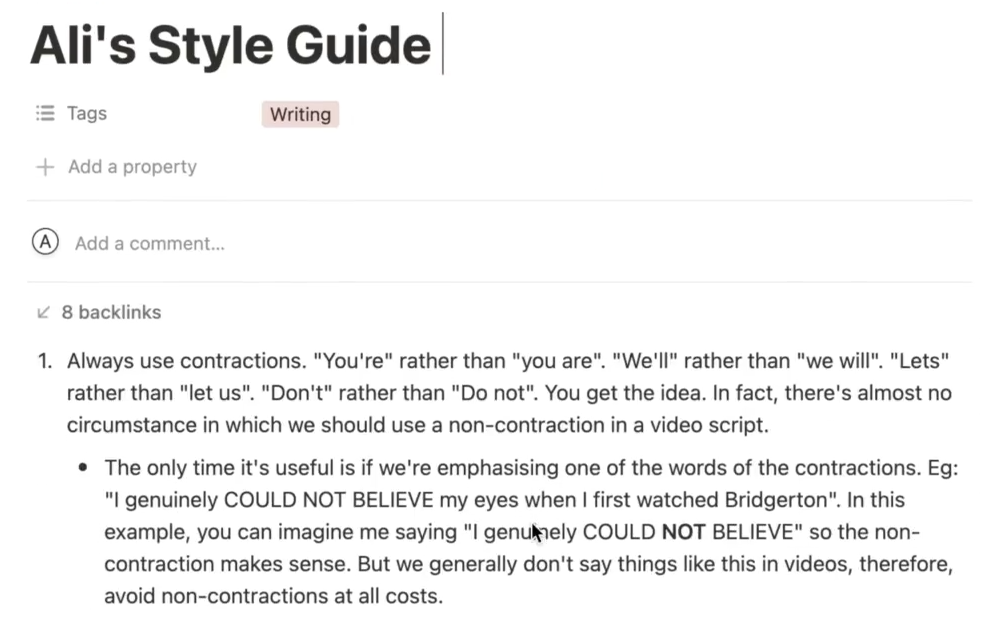
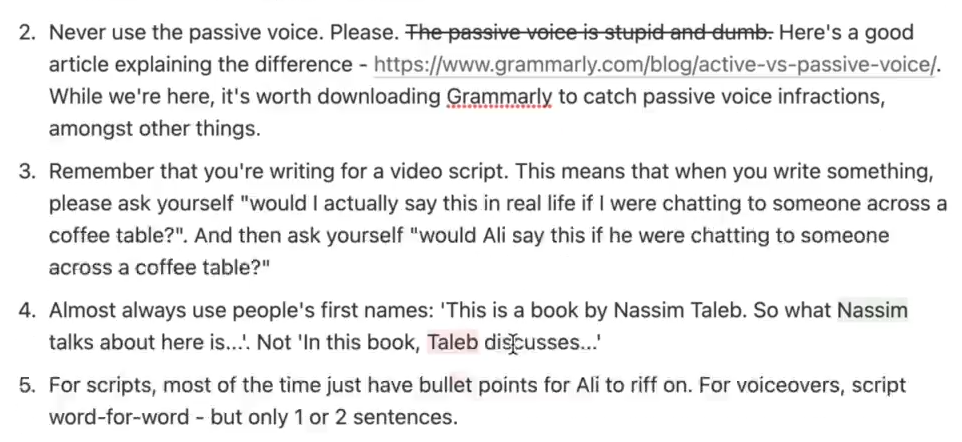
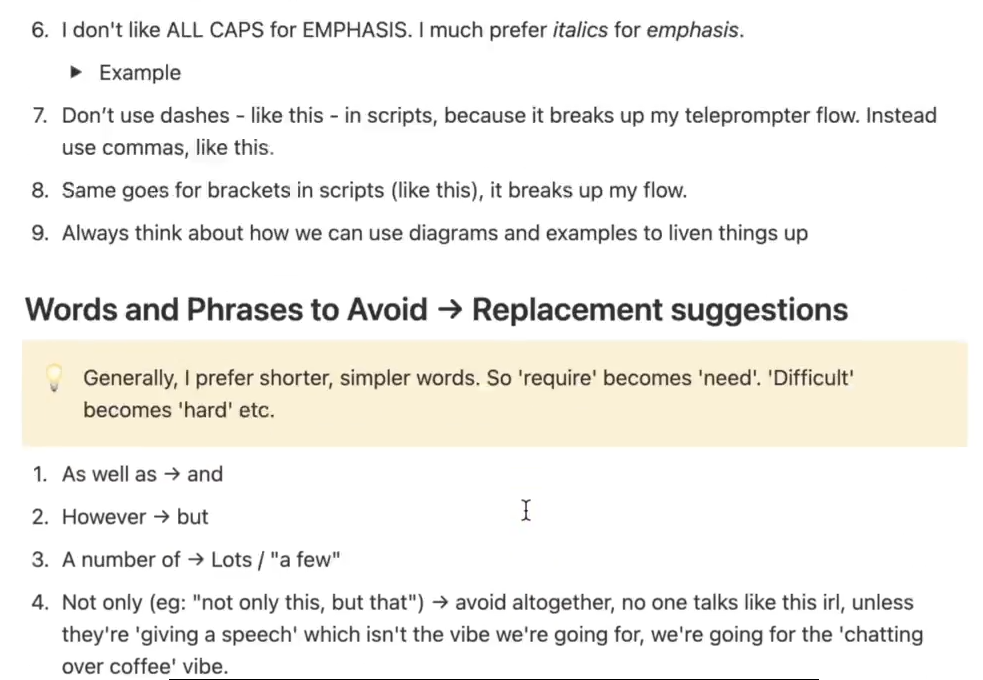
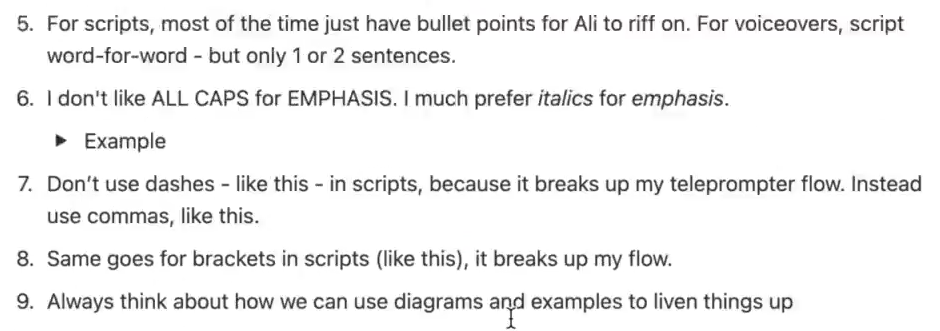
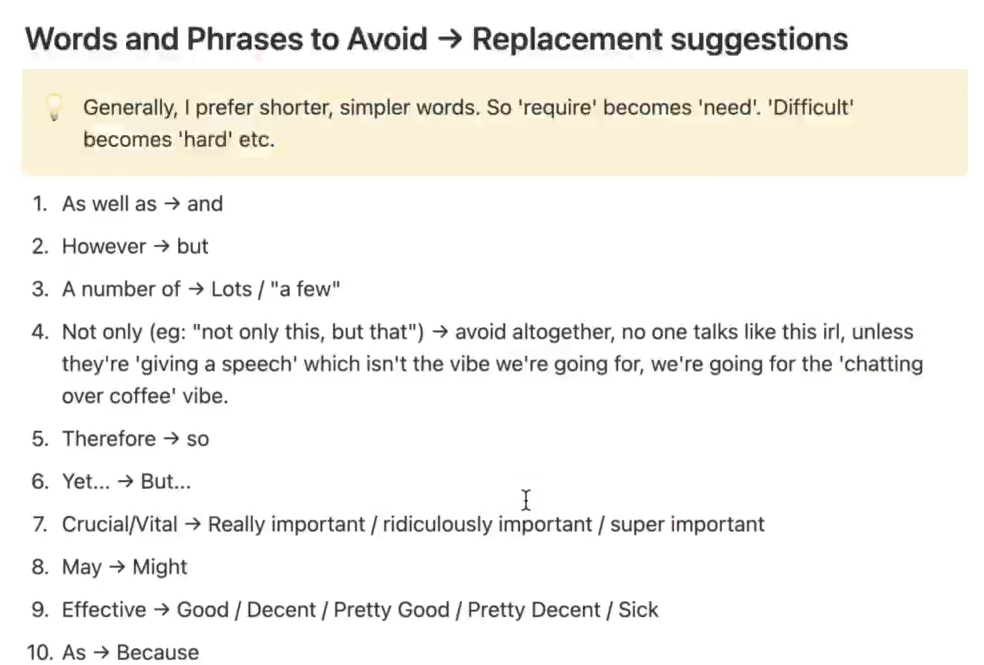
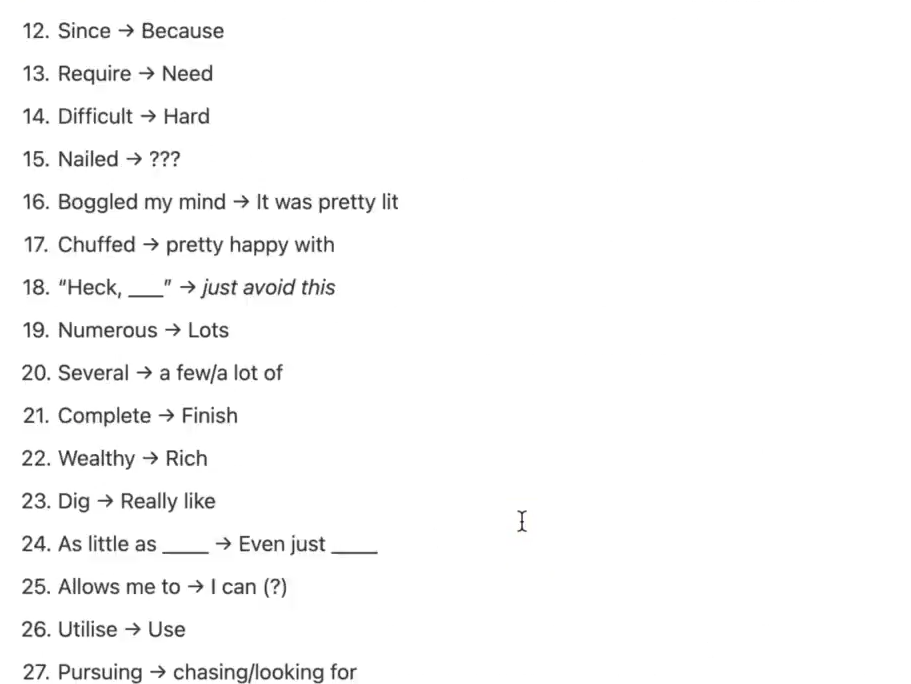
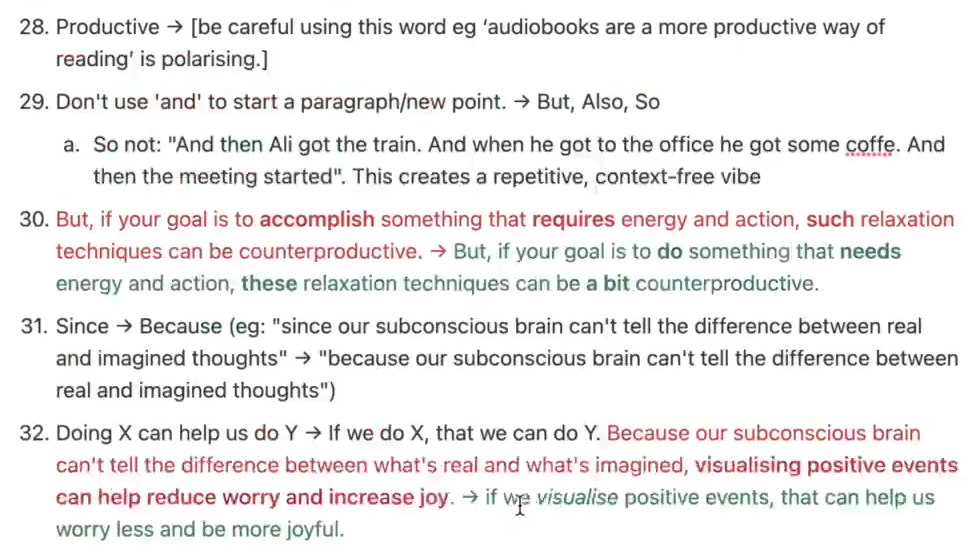
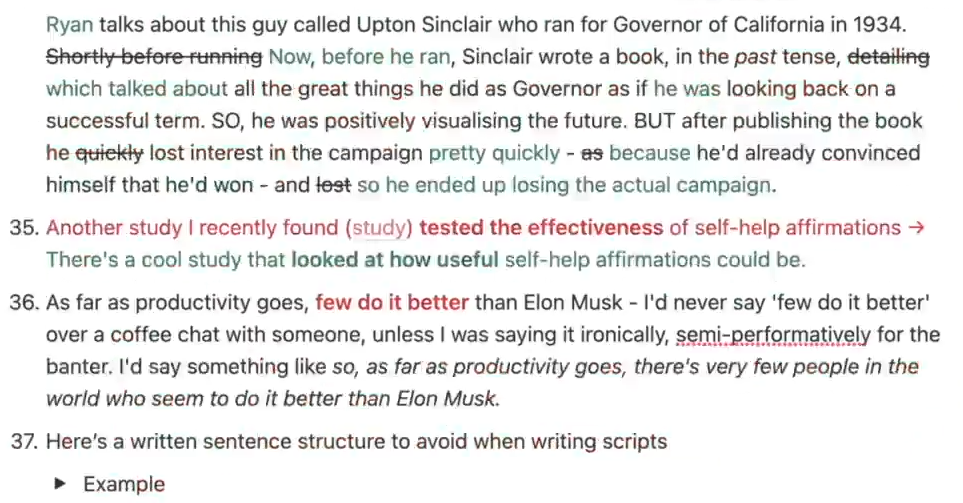
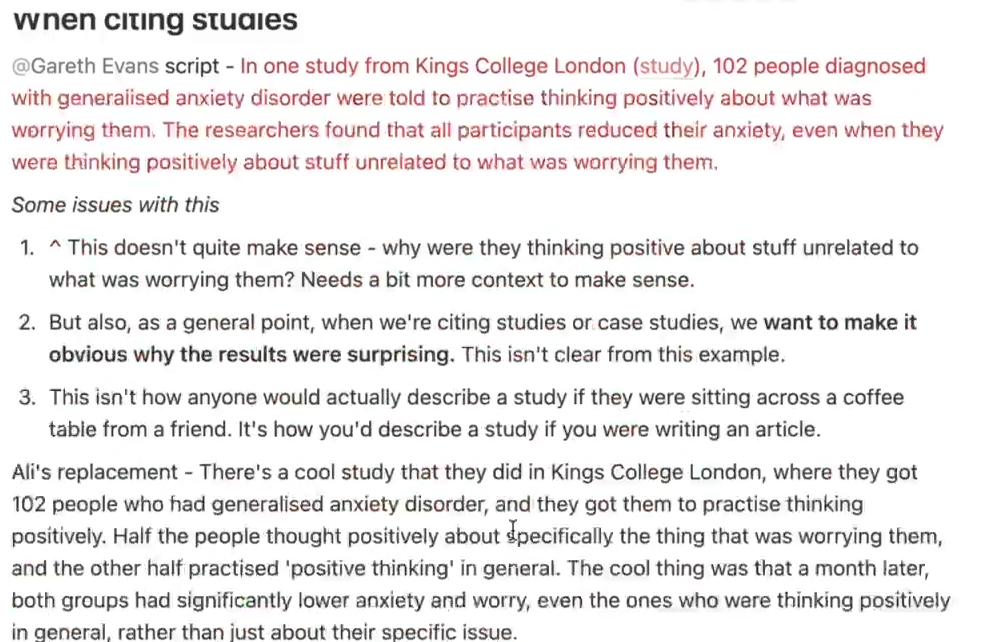
How to Film YouTube Videos on Your Phone
📺 Video
Video
La app integrata per cellulare non va benissimo, meglio usare una app dedicata come Filmic Pro, questa permette di impostare dei setting particolari per esempio:
- 25 fps. 30 fps o più rendono il video un po’ più artefatto.
- 16:9; 4k 2160p e bitrate al più alto possibile
- Shutter speed: 1/50 (deve essere il doppio degli fps, 18°C rule)
- White balance: 6125k +0 to +2 tint
Audio
L’audio è importante come il video con la differenza che l’audio integrato negli smartphone non è il massimo della vita.
Esistono delle soluzioni intermedie come il RØDE VideoMicro che permettono di avere un audio decente con 50€.
Luce
Anche la luce è molto importante ma senza spendere soldi per ring light e similari va bene sedersi vicino ad una finestra molto grande per avere molta luce naturale che va bene.
Framing
E’ comodo avere uno schermo dove vedere quello che si sta riprendendo: usare la fotocamera anteriore del cellulare è molto LQ e, senza spendere soldi in un monitor esterno, conviene collegare il cellulare al PC in modo da vedere in diretta quello che sto vedendo (per esempio con QuickTime player).
Treppiede
Va bene qualsiasi di Amazon basta che sopra abbia un attacco per microfono, tipo il RØDE di cui sopra. Ancora meglio se è compatibile con il GorrillaPod in modo da poter connettere qualsiasi treppiede al telefono
Wide lenses
Acquistare una lente grandangolare per cellulare permette di avvicinarsi molto al dispositivo ottenendo un risultato analogo al non usarla.
Il vantaggio è che avvicinandosi molto sono più vicino al microfono e conseguentemente l’audio è migliore. Non indispensabile ma comunque un buon trucco.
Template Notion
https://aliabdaal.notion.site/YouTube-Notion-Templates-Repository-d27debcf0ded49698882579b9529d488